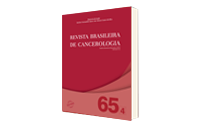Nanoparticles in Cancer Treatment: General Aspects, Antineoplastic Mechanisms of Action and Tumor Applications
DOI:
https://doi.org/10.32635/2176-9745.RBC.2019v65n4.400Keywords:
Nanoparticles/administration & dosage, Nanoparticles/ therapeutic use, Neoplasms, Antineoplastic AgentsAbstract
Introduction: Technological advances in recent decades have led to the development of therapeutic approaches in medicine on a new scale of nanometric molecular applications, allowing the establishment of new therapies such as nanotherapy. The use of nanoparticles entails numerous opportunities as well as major challenges for human application where use requires a thorough understanding of the biocompatibility and pharmacodynamics of molecules. In cancer, nanoparticles act mainly in the active forms that are characterized by the use of ligands or antibodies on their surfaces where they bind to certain cells, and in the passive form, where particles accumulate in tumor tissues due to the large fractions of tumor endothelium. Objective: To address the main properties of protein, metal, polymer and lipid nanoparticles, their structures and uses against specific cancer cells and the advantages and disadvantages of their use. Method: Selection of articles with studies on nanoparticles from 2010 to 2018 in the PubMed and SciELO databases through narrative review of the literature. Results: Nanoparticles have different mechanisms of action and may obtain more favorable results according to their chemical structure. Conclusion: Based in this review, it was concluded that certain nanoparticles have functionalities that enhance the anticancer effects of antineoplastic drugs and emerge as a new approach for cancer treatments.









